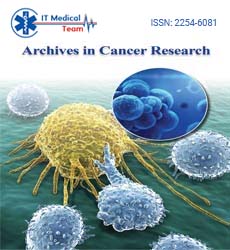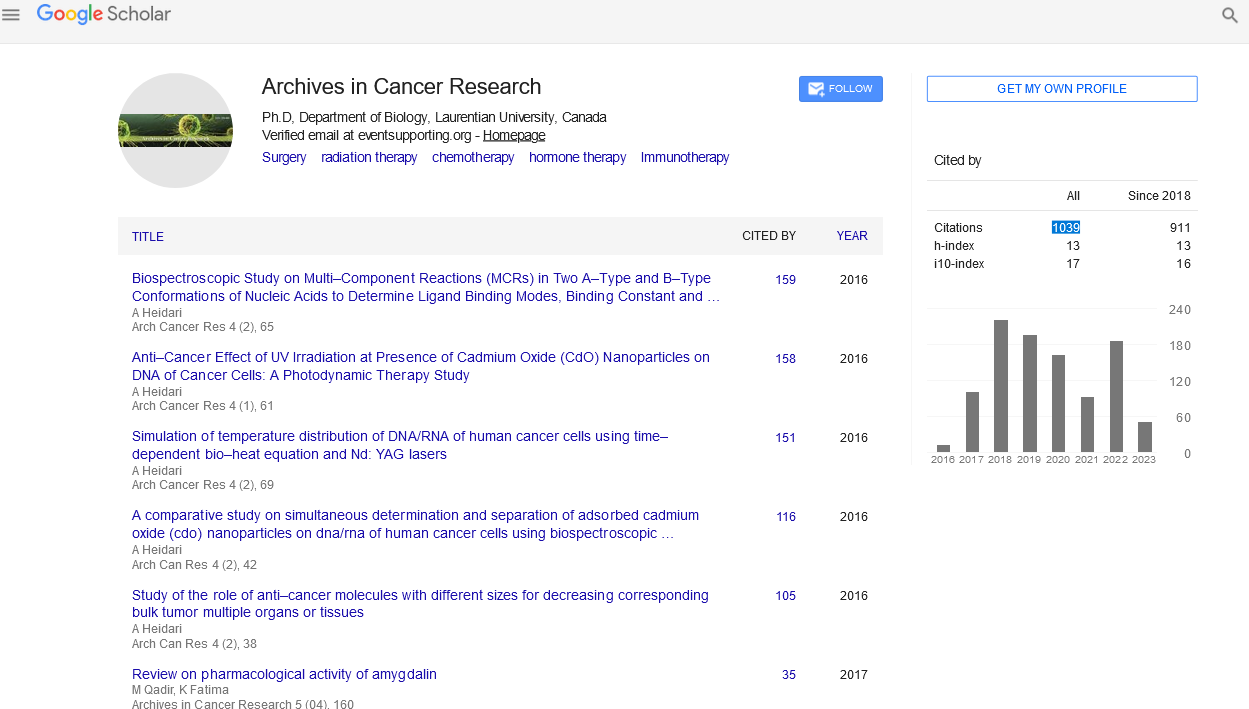Perspective - (2024) Volume 12, Issue 4
Chemoprevention: A Proactive Approach to Cancer Prevention
Choon Yahu*
Department of Oncology, University of Oxford, United Kingdom
*Correspondence:
Choon Yahu, Department of Oncology, University of Oxford,
United Kingdom,
Email:
Received: 19-Jul-2024, Manuscript No. IPACR-24-15000;
Editor assigned: 22-Jul-2024, Pre QC No. IPACR-24-15000 (PQ);
Reviewed: 05-Aug-2024, QC No. IPACR-24-15000;
Revised: 13-Aug-2024, Manuscript No. IPACR-24-15000 (R);
Published:
22-Aug-2024
Introduction
Chemoprevention refers to the use of natural or synthetic
substances to prevent, delay, or reverse the development of
cancer. The concept emerged in response to the need for
innovative strategies to combat the rising incidence of cancer
worldwide. Chemoprevention aims to intervene early in the
carcinogenic process, targeting pre-cancerous cells before they
transform into malignant tumors. This approach offers a promising
avenue for reducing the burden of cancer, complementing
traditional methods such as surgery, chemotherapy, and radiation.
Description
The mechanism of chemoprevention
Chemopreventive agents work through various mechanisms
to inhibit cancer development. These mechanisms include:
Antioxidant activity: Many chemopreventive agents act as
antioxidants, neutralizing free radicals that can cause DNA
damage and initiate carcinogenesis. Vitamins C and E, selenium,
and polyphenols in green tea are examples of substances with
antioxidant properties.
Anti-inflammatory effects: Chronic inflammation is a known
risk factor for several types of cancer. Nonsteroidal Anti-
Inflammatory Drugs (NSAIDs) like aspirin and ibuprofen have
been shown to reduce the risk of colorectal cancer by inhibiting
enzymes involved in the inflammatory process.
Hormonal modulation: Hormone-related cancers, such as breast
and prostate cancer, can be influenced by agents that modulate
hormone levels. Selective Estrogen Receptor Modulators (SERMs)
like tamoxifen and raloxifene are used to prevent breast cancer in
high-risk women by blocking estrogen receptors.
Enzyme induction/inhibition: Certain enzymes are involved in
the activation or detoxification of carcinogens. Agents like
sulforaphane, found in cruciferous vegetables, can induce
detoxifying enzymes and inhibit the activation of pro-carcinogens.
Apoptosis induction: Promoting programmed cell death
(apoptosis) in pre-cancerous or cancerous cells can prevent the
progression of cancer. Compounds like curcumin from turmeric
and resveratrol from grapes have been shown to induce
apoptosis in various cancer cell lines.
DNA repair enhancement: Some chemopreventive agents
enhance the body's ability to repair damaged DNA, reducing the
likelihood of mutations that can lead to cancer. Agents like folate
and certain polyphenols play roles in DNA repair mechanisms.
Categories of chemopreventive agents
Chemopreventive agents can be broadly classified into three
categories: Natural compounds, pharmaceutical drugs, and
dietary supplements.
Natural compounds
Natural compounds derived from plants, herbs, and other
sources have been extensively studied for their chemopreventive
properties. Examples include:
Curcumin: Derived from turmeric, curcumin has antiinflammatory,
antioxidant, and apoptosis-inducing properties. It
has shown promise in preventing cancers of the colon, breast,
prostate, and pancreas.
Green tea polyphenols: Epigallocatechin Gallate (EGCG), a
major polyphenol in green tea, has antioxidant and antiinflammatory
effects. Studies suggest it may reduce the risk of
breast, prostate, and colorectal cancers.
Resveratrol: Found in grapes and red wine, resveratrol has
been shown to inhibit cancer cell proliferation and induce
apoptosis. It is studied for its potential in preventing breast,
prostate, and colon cancers.
Sulforaphane: This compound, abundant in cruciferous
vegetables like broccoli, induces detoxifying enzymes and has
been shown to inhibit the growth of various cancer cells.
Pharmaceutical drugs
Several pharmaceutical drugs have been repurposed for their
chemopreventive effects. These include:
Aspirin: Long-term use of low-dose aspirin has been
associated with a reduced risk of colorectal cancer. It is believed
to inhibit the Cyclooxygenase (COX) enzymes involved in
inflammation and carcinogenesis.
Tamoxifen and raloxifene: These SERMs are used to reduce
the risk of breast cancer in high-risk women by blocking estrogen
receptors in breast tissue.
Metformin: Originally used to treat type 2 diabetes, metformin
has shown potential in reducing the risk of several cancers,
including breast, colorectal, and pancreatic cancers, possibly by
lowering insulin levels and inhibiting cell proliferation.
Dietary supplements
Dietary supplements containing vitamins, minerals, and other
bioactive compounds are widely used for their potential
chemopreventive effects. Examples include:
Vitamin D: Adequate levels of vitamin D have been linked to a
reduced risk of colorectal, breast, and prostate cancers. It is
thought to regulate cell growth and differentiation.
Omega-3 fatty acids: Found in fish oil, omega-3 fatty acids
have anti-inflammatory properties and have been studied for
their role in preventing breast, prostate, and colorectal cancers.
Folate: This B-vitamin is essential for DNA synthesis and
repair. Adequate folate intake has been associated with a
reduced risk of colorectal cancer.
Clinical evidence and challenges
While the potential of chemoprevention is promising,
translating these findings into clinical practice poses several
challenges. Clinical trials are essential to establish the efficacy
and safety of chemopreventive agents, but such trials are often
lengthy, costly, and complex.
Clinical trials
Numerous clinical trials have been conducted to evaluate the
effectiveness of chemopreventive agents. Some notable
examples include:
Breast Cancer Prevention Trial (BCPT): This landmark study
demonstrated that tamoxifen reduced the incidence of breast
cancer by nearly 50% in high-risk women.
Aspirin and esophageal cancer: A large cohort study found
that regular aspirin use was associated with a significantly
reduced risk of esophageal cancer.
SELECT trial: The Selenium and Vitamin E Cancer Prevention
Trial (SELECT) investigated the effects of selenium and vitamin E
on prostate cancer risk. Unfortunately, the trial did not find a
protective effect and raised concerns about potential harm.
Challenges
Several challenges hinder the widespread adoption of
chemoprevention:
Identifying high-risk individuals: Targeting chemopreventive
strategies to individuals at high risk of cancer is crucial. Genetic,
environmental, and lifestyle factors must be considered
to identify those who would benefit most.
Long-term safety: Long-term use of chemopreventive agents
raises concerns about potential side effects and toxicity.
Rigorous safety assessments are necessary to ensure that the
benefits outweigh the risks.
Adherence: Adherence to chemopreventive regimens can be
challenging, especially for asymptomatic individuals. Education
and counseling are needed to improve adherence and maximize
the benefits.
Cost-effectiveness: The cost of chemopreventive agents and
their implementation in public health strategies must be
considered. Cost-effectiveness analyses help determine the
feasibility of widespread adoption.
Future directions
The field of chemoprevention is evolving, with ongoing
research exploring new agents, biomarkers, and personalized
approaches.
Personalized chemoprevention
Advances in genomics and molecular biology are paving the
way for personalized chemoprevention. By understanding an
individual's genetic predisposition and molecular profile, tailored
chemopreventive strategies can be developed. For example,
individuals with specific genetic mutations (e.g., BRCA1/2) may
benefit from targeted chemopreventive agents.
Combination therapies
Combining multiple chemopreventive agents may enhance
their efficacy and target multiple pathways involved in
carcinogenesis. Synergistic effects can be achieved by combining
agents with complementary mechanisms of action. For example,
combining aspirin with a COX-2 inhibitor may provide greater
protection against colorectal cancer than either agent alone.
Novel agents
Research is ongoing to identify novel chemopreventive agents
from natural sources, pharmaceuticals, and dietary supplements.
High-throughput screening and advanced analytical techniques
are accelerating the discovery of new compounds with potential
chemopreventive properties.
Conclusion
Chemoprevention represents a proactive approach to cancer
prevention, aiming to intervene early in the carcinogenic process
and reduce the incidence of cancer. While significant progress
has been made in identifying and evaluating chemopreventive
agents, several challenges remain. Continued research, clinical
trials, and personalized approaches are essential to realize the
full potential of chemoprevention. By embracing this strategy,
we can move closer to a future where the burden of cancer is
significantly reduced, improving the quality of life for individuals
worldwide.
Citation: Yahu C (2024) Chemoprevention: A Proactive Approach to Cancer Prevention. Archives Can Res Vol:12 No:4





